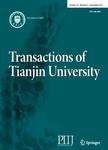Data-Driven Design of Single-Atom Electrocatalysts with Intrinsic Descriptors for Carbon Dioxide Reduction Reaction
作者机构:Key Laboratory for Green Chemical Technology of Ministry of Education School of Chemical Engineering and Technology Tianjin University Collaborative Innovation Center of Chemical Science and Engineering(Tianjin) School of Economics and Management Tianjin University of Technology and Education Department of Chemistry University of the Free State Haihe Laboratory of Sustainable Chemical Transformations National Industry-Education Platform of Energy StorageTianjin University Joint School of National University of Singapore and Tianjin University International Campus of Tianjin University
出 版 物:《Transactions of Tianjin University》 (天津大学学报(英文版))
年 卷 期:2024年第05期
页 面:459-469页
学科分类:12[管理学] 1201[管理学-管理科学与工程(可授管理学、工学学位)] 081705[工学-工业催化] 08[工学] 0817[工学-化学工程与技术] 081104[工学-模式识别与智能系统] 080502[工学-材料学] 0805[工学-材料科学与工程(可授工学、理学学位)] 0835[工学-软件工程] 0811[工学-控制科学与工程] 0812[工学-计算机科学与技术(可授工学、理学学位)]
基 金:the National Key R&D Program of China (No. 2022YFE0102000) the National Natural Science Foundation of China (Nos. 22121004, U22A20409, 22250008, and 22108197) the Haihe Laboratory of Sustainable Chemical Transformations, the Natural Science Foundation of Tianjin City (No. 21JCZXJC00060) the Program of Introducing Talents of Discipline to Universities (No. BP0618007) the XPLORER PRIZE for financial support
摘 要:The strategic manipulation of the interaction between a central metal atom and its coordinating environment in single-atom catalysts(SACs) is crucial for catalyzing the CO2reduction reaction(CO2RR). However, it remains a major challenge. While density-functional theory calculations serve as a powerful tool for catalyst screening, their time-consuming nature poses limitations. This paper presents a machine learning(ML) model based on easily accessible intrinsic descriptors to enable rapid, cost-effective, and high-throughput screening of efficient SACs in complex systems. Our ML model comprehensively captures the influences of interactions between 3 and 5d metal centers and 8 C, N-based coordination environments on CO2RR activity and selectivity. We reveal the electronic origin of the different activity trends observed in early and late transition metals during coordination with N atoms. The extreme gradient boosting regression model shows optimal performance in predicting binding energy and limiting potential for both HCOOH and CO production. We confirm that the product of the electronegativity and the valence electron number of metals, the radius of metals, and the average electronegativity of neighboring coordination atoms are the critical intrinsic factors determining CO2RR activity. Our developed ML models successfully predict several high-performance SACs beyond the existing database, demonstrating their potential applicability to other systems. This work provides insights into the low-cost and rational design of high-performance SACs.



